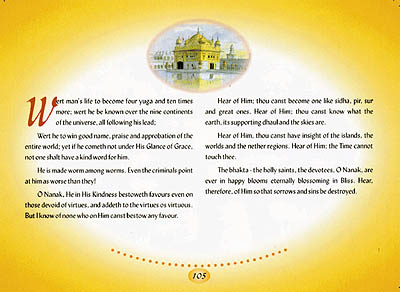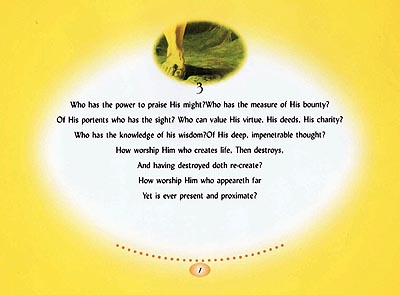Guru Nanak
and national integration
By Gurbachan
Singh Talib
NATIONAL integration is a phrase
which we have recently added to our social-cum-political
vocabulary. While India has been divided and fragmented
for millennia over religion, caste, language and region,
attempts have been made by our Sufis and religious
teachers from time to time to bring about cohesion and
harmony. While at a particular period of history a fair
amount of such cohesion was achieved by shared beliefs in
what is called Hinduism, there nevertheless were
tendencies of a centrifugal nature, as would inevitably
exist in any society spread over such a vast area as our
country. These were tendencies towards division of the
whole mass into sects and castes and subcastes. Partly
the origin of such division was racial as between Aryan
and non-Aryan. We need not go here into bewildering
varieties of these that have obtained in our country for
centuries beyond precise determination.

With the coming of
Islam, which unlike the earlier influences that entered
that country could not be digested into the body of
Hinduism, nor would agree to live in harmony with it, a
new and continuing conflict arose, which in some form or
the other is alive till today; and having entered the
political field in the form of the pursuit of power and
the creation of Pakistan, has indubitably been
intensified. Along with the two major groups that are
loosely called Hinduism and the Islamic millat,
may be reckoned other religious factors like Sikhism,
Christianity and a number of tribal creeds. While
numerous religions exist alongside each other in most
countries, in India their conflict and rivalry has taken
a particularly violent form, mainly because of the
centuries-old course of conquest of Islam and Hindu
resistance thereto in various forms — military,
social and credal.
While present-day
political ideologies try to minimise such conflict, it
nevertheless has been real in history and has left bitter
race memories particularly among non-Muslims, which at
any time can be easily revived and made to start
conflicts. With the Muslims it is a memory of lost glory
and a crusading zeal. Part of the bitterness arose from
the fact of the Hindu generally being the money-lender
and the Muslim the insolvent debtor. Any attempt at
bringing about national integration must reckon with this
fact rather than gloss it over by fine phrases and
fancied appeals in the past for harmony.
A new factor of
disharmony that has entered the Indian scene is the
upsurge for human rights among the so-called untouchables
and the other depressed classes, kept down by the
sanction of religion. But this part of the conflict is a
recent phenomenon and is the result of the arousing of
the conscience of the higher castes among the Hindus
themselves as a result of enlightenment brought in by the
modern humanism and science. The British rulers did
little to ameliorate the condition of these classes,
except indirectly and involuntarily as, for example, in
common rail travel for all and recruitment of
untouchables to the armed forces.
The crux of it all is
that while the caste factor is now important in
disrupting harmony and retarding integration, the
Hindu-Muslim conflict, added to which may be such
conflicts as the Sikh-Hindu bickering in Punjab and
Haryana, is the major case of tension, and in chalking
out any programme of integration, the effort must be
concentrated on diluting it. Perhaps with the passage of
time and the emergence of new socio-political factors
like the class-conflict,this side of tension may be
softened down, but at present it is strong and bitter, as
resentment suppressed and open everywhere shows.
A happy feature of our
social life in the past was the people living in the
countryside, away from that influence of hate-spitting
theologians. While the Muslims of foreign origin did
maintain a superior stance, those who were descendants of
local converts and followed occupations parallel to their
Hindu counterparts, seldom thought in terms of conflict.
They had their system of faith and social customs
paralleled to the Hindus, with a kind of coexistence.
What kept all at peace was common subjection to the
exactions of the feudal lords, Hindu and Muslim.
Individually there was little to be gained on a class
basis, and so unlike our present-day political conflicts,
struggle was personal and individual or at best familial.
At the folk level people even had common religious
teachers in the form of local saints and hermits. It was
the kazis and mullahs, bigoted theologians
who thought in term of suppressing kufr of heresy.

Among the seers of India
the one who made the most potent and persistent effort
towards reconciling the warring groups in the Indian
populace was Guru Nanak. In respect of what we now term
national integration and what in his day would be known
as humanitarianism, his effort took a two-fold form. With
regard to the caste conflict, while he upbraided the
Brahmin for his claim of inherent purity and exclusive
guardianship of spiritual enlightenment, he declared
spiritual instruction to be the universal right of all
without distinction of caste. This in those times was a
revolutionary step. Even in our day such a right has
found only tardy and reluctant acceptance. Despite being
a high caste man himself, he felt deeply the deprivation
of the lower castes from spiritual instruction. It was
not their social degradation that primarily moved his
compassion, but the fact that they were treated as
without souls, who did not need the ministration of
religion.
Guru Nanak sought to
integrate the lower castes into the mainstream of Indian
humanity. In one place he affirmed Nanak navain bajh
sanat (those living without God are the really
low-caste). In another place he called the lower
tendencies of the mind such as foul thinking (kubudhi),
hard-heartedness (kudaya), wrath (krodh)
and such others the real untouchables. Guru Nanak
identified himself in feelings with those considered low
caste and held in contempt. In one of his famous
pronouncements he declared:
Lowest of the low am I,
with the lowly identified.
Saith Nanak: Lord: thy
glance of grace falls on the land where the lowly are
cherised.
In an ecstatic mood of
compassion he declared: Great is the merit of those of
the higher castes serving God: One among the lower castes
serving Him may even wear shoes made from my skin.
The problem of
untouchability and even of caste gradations has not been
solved with us yet. Certain economic and sociological
factors however, are at play leading towards such an end,
The effect of Guru Nanak’s teaching has been that
the castes considered low, without being untouchables,
have had a better deal among the Sikhs particularly and
in Punjab generally than elsewhere in India.
Untouch-ability too here has been practised in a softened
form compared to the rest of the country.
With regard to what is
called communal rancour or the conflict of faith with
faith, what Guru Nanak sought to achieve was
reconciliation. Some writers on Sikhism, whose knowledge
of the Sikh scriptural writing is only perfunctory have
tried to show him in the role of a synthesiser of faiths.
This is no way sustainable. His was a revelation of an
integrated system of faith and the spiritual life, and
not a synthesised group of beliefs borrowed from here and
there. In a scene of conflicting faiths, while calling
upon no one to abjure his faith or to seek conversion to
another, he sought to impart to all men the vision of a
common moral system for all humanity, irrespective of the
faith anyone might profess.
Rituals, sacrements and
symbols there are. He did not interfere with them. If it
was the Hindu holy bath, what he commended was purity of
heart and not mere ontoward ablutions. With regard to the
sacred thread of the Hindus, he did not ask anyone to
discard the practice of assuming it, but adjured that it
be made up of noble qualities of the soul, such as
compassion, contentment continence and purity of heart.
These and not mere twisted yarn would make the sacred
thread of the soul. A similar transmutation of ritual
with moral and spiritual qualities did he commend in the
case of the practitioners of hatha yoga. Their
earrings, begging pouch, staff etc, he adjured them to
make into contentment, modesty, meditation and such other
attributes of the ennobled and enlightened self.
Coming to Islam which
stood in a stance of straight confrontation/contradiction
with the Indian-born creeds cumulatedly known as
Hinduism, he offered bold insights. Right from the dawn
of his revelation he had declared his aversion to the
barriers created by bigotry by raising the cry:
‘There is no Hindu and no Mussalman’. Earlier
he was charged with perverting both Hinduism and Islam by
people who did not understand the gospel of a universal
morality that he was preaching. During his visit to Mecca
as the Muslim divines asked him which was superior,
Hindus or Muslims, came the reply: "Without good
deeds both shall come to suffering."
The query put to him had
in it the implict answer that Islam was superior, for
such was the conviction instilled in the mind of the
Muslim faithful. Addressing Muslim groups he sought to
guide them along the same path of a universal morality
that he had indicated to the followers of popular
Hinduism and yoga. His affirmation to the Muslims are
contained particularly in the Var in the measure Majh,
a few of which may be given here in rendering.
Addressing them in a group he affirmed:
"Hard it is to
become a true Muslim;
Only one truly such may
be so called;
His first action, to
love the way of the holy;
Second, to shed off his
heart’s filth as on the grindstone.
One professing to be a
guide to Muslim must shed the illusion of life and death.
To God’s will must
he submit:
Obey God and efface his
self.
Such a one shall be a
blessing for all,
And be truly reckoned a
Muslim.
Again, transmuting the
Muslim’s articles of Shariat into moral and
spiritual qualities, he declared:
Make thy mosque of love
of humanity;
Thy prayer-carpet of
sincerity;
Thy Koran of honest and
approved endeavour;
Thy circumcision of
modesty;
Thy Ramazan fast of
noble conduct;
Thus shalt thou be a
true Muslim.
Make good deeds thy
Kaba;
Truthfulness thy
preceptor;
Thy namaz and kalima
pure actions;
The rosary what pleases
God —
Thus wilt thou be
honoured at the last reckoning.
Five are the prayers,
five the hours to perform them,
Five their different
names;
What are the true
prayers
The first is
truthfulness, the next honest endeavour;
The third prayer offered
to God for good of all;
The fourth is a sincere
heart;
The fifth, divine
laudation.
One whose kalima is
good actions is alone a true Muslim.
Saint Nanak; All who are
false within, in the end prove of no worth.
Rising to a higher
emphasis, he declared about the apparent divergences of
creed, particularly as between Hinduism and Islam.
He who knows the two
paths to be one.
Shall alone find
fulfilment.
The evil slanderer and
caviller must burn in hellfire.
The whole universe is
divine in essence.
Merge yourselves into
truth.
Tolerance comes easy to
people who under the impact of intellectualism or some
ideology have abjured faith in religion. To such all
faiths naturally are equally unacceptable.
Where people are deeply
religious as in our country and over a great part of the
world, the only way to bring out goodwill and work for
what may be called integration is Guru Nanak’s way
of propagating a universal morality that may cut across
the bounds of creeds and bind all men of goodwill in the
practice of the gospel for the new man — the man of
tomorrow. 
|

